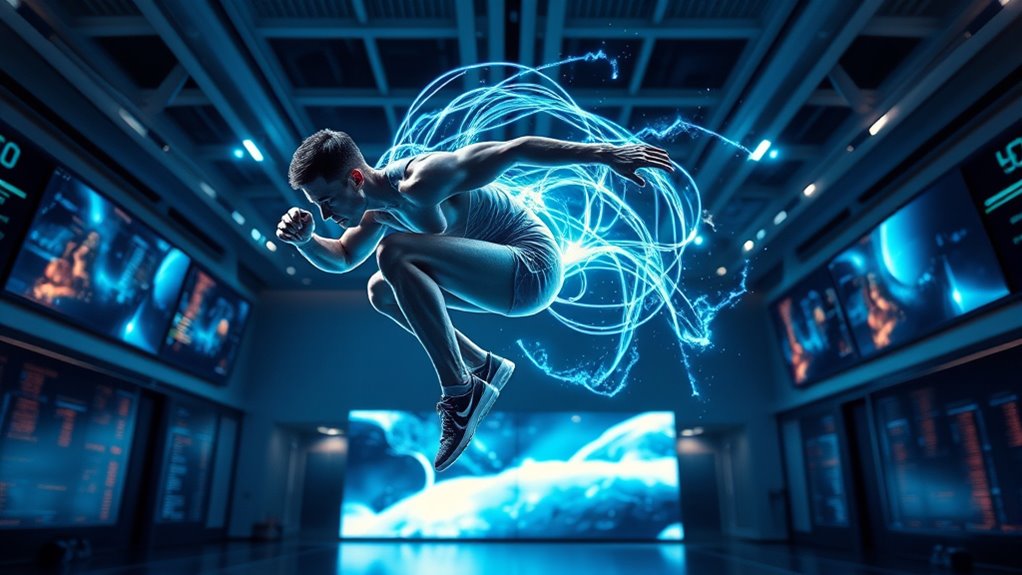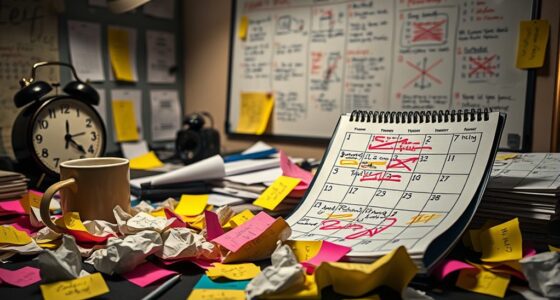You borrow visualization techniques from NASA to boost your athletic performance by mentally rehearsing your routines. Just like astronauts use detailed mental imagery to prepare for space missions, you can imagine every detail of your activities, engaging your senses and building confidence. Setting clear goals guides your mental practice, helping you focus on specific improvements. Keep exploring these methods, and you’ll discover how combining mental rehearsal with goal setting can give you a mental edge.
Key Takeaways
- Athletes adopt NASA-inspired mental rehearsal to vividly visualize performance scenarios, enhancing focus and confidence.
- NASA’s structured visualization techniques involve multi-sensory imagery to simulate complex physical tasks mentally.
- Goal setting is integrated with visualization, helping athletes mentally practice incremental steps toward success.
- Consistent mental practice, as used by NASA, solidifies neural pathways and improves real-world athletic performance.
- These techniques create realistic mental scenarios, giving athletes a competitive edge and mental readiness.

Many athletes are now turning to NASA’s advanced visualization techniques to boost their performance. This approach isn’t just about imagining success; it involves a structured mental rehearsal that prepares your mind and body for real-world execution. NASA scientists have perfected these techniques to help astronauts mentally practice complex tasks in space, and now, athletes are borrowing this strategy to enhance their own athletic skills. When you engage in mental rehearsal, you vividly picture yourself performing at your best, which helps solidify neural pathways and builds confidence. The key is to create a detailed, realistic visualization of your activity, from start to finish, so your brain accepts it as a real experience.
Athletes use NASA’s visualization techniques to mentally rehearse and boost performance through detailed, realistic mental practice.
Goal setting plays an essential role in this process. Before you begin your mental rehearsal, you need to establish clear, specific objectives. Whether you’re aiming to improve your sprint time, perfect a golf swing, or master a gymnastics routine, having well-defined goals guides your visualization and keeps you focused. NASA’s approach emphasizes the importance of setting incremental goals, which break down complex tasks into manageable steps. As you visualize, you should imagine yourself successfully completing each step, feeling the emotions associated with achievement. This not only boosts motivation but also primes your brain for actual performance, reinforcing the connection between mental images and physical outcomes.
To get the most out of these visualization techniques, you should be consistent and deliberate. Dedicate time regularly—preferably before workouts or competitions—to mentally rehearse your routines. Find a quiet environment where you can close your eyes and immerse yourself fully in the experience. Use all your senses during visualization: hear the sounds, feel the textures, and imagine the sensations of movement. This multi-sensory engagement makes your mental rehearsal more effective and believable. Additionally, understanding that these techniques are rooted in Natural Environment principles can help you appreciate their effectiveness in creating realistic scenarios.
NASA’s success with visualization underpins its value for athletes. They understand that the mind can simulate physical activity with remarkable accuracy, which is why mental rehearsal combined with clear goal setting has become a powerful tool in sports training. When you adopt these techniques, you’re not just dreaming about success; you’re actively training your brain to execute your best performance. Over time, this mental practice can translate into real-world improvements, giving you a mental edge that complements physical training. In summary, by borrowing these NASA-inspired methods, you prepare your mind as thoroughly as your body, setting the stage for peak performance every time.
Frequently Asked Questions
How Do Athletes Adapt Nasa’s Visualization Methods for Individual Sports?
You can adapt NASA’s visualization methods for individual sports by using mental rehearsal to imagine your performance vividly. Focus enhancement becomes easier as you visualize specific skills and scenarios, helping you stay calm and confident. By mentally practicing your techniques and strategies, you strengthen neural pathways, improve concentration, and prepare for competition. This active engagement with your mental imagery boosts your overall performance, making you more prepared and focused during actual events.
What Psychological Effects Do These Visualization Techniques Have on Athletes?
You experience a mental focus boost when using visualization techniques, as your mind rehearses successful performance scenarios. This mental practice helps reduce anxiety and builds confidence, making you feel more prepared and in control during competitions. As a result, you perform with greater clarity and calmness, reinforcing a positive mindset. These psychological effects can markedly enhance your overall athletic performance by fostering resilience and a stronger belief in your abilities.
Are There Specific NASA Projects That Inspired These Visualization Strategies?
You might wonder if specific NASA projects inspired these visualization strategies. Indeed, NASA’s Apollo missions and Mars rover visualizations played a role, demonstrating how astronauts and engineers mentally prepare for complex tasks. These projects showcase detailed imagery and immersive simulations, which athletes adapt for mental rehearsal. By studying these NASA techniques, you can enhance focus, boost confidence, and improve performance through vivid, realistic mental scenarios.
How Long Does It Typically Take for Athletes to See Results From These Techniques?
You might wonder how long it takes to see results from visualization techniques. In most cases, with consistent training duration, athletes start noticing improvements within a few weeks to a few months. Success timeline varies depending on individual dedication and practice quality. Like planting a seed, persistence pays off, and over time, visualization can become a powerful tool to boost performance, often yielding noticeable gains in mental clarity and confidence.
Can Visualization Techniques Improve Performance in Team Sports as Well?
Yes, visualization techniques can improve your performance in team sports. By practicing mental rehearsal, you strengthen your focus and coordination, which boosts individual skills. It also enhances team cohesion, as you mentally prepare for plays and communication. When everyone uses visualization, your team can synchronize better, leading to improved game strategies and overall success. So, incorporating mental rehearsal into your training can make a real difference on the field.
Conclusion
By adopting NASA’s visualization techniques, you can boost your athletic performance. Imagine yourself executing a perfect jump or sprint, mentally rehearsing every detail just like astronauts do before a space mission. For example, a runner might visualize crossing the finish line flawlessly, building confidence and focus. These mental images help reduce anxiety and improve results. So, next time you train, picture success vividly—your mind’s eye can truly propel you toward greatness.










